Moira Ritter
Fri, February 2, 2024
Hundreds of years ago, during the height of the Mayans’ rule in Guatemala, someone was buried in a huge tomb filled with “extraordinary” and “rare” offerings.
The burial barely survived an aggressive looting campaign, which included extensive underground tunnels that allowed robbers to unearth ancient artifacts left by the Mayans. It stayed hidden by the jungle for nearly 1,700 years.
That is until now, according to archaeologists from Tulane University in New Orleans.
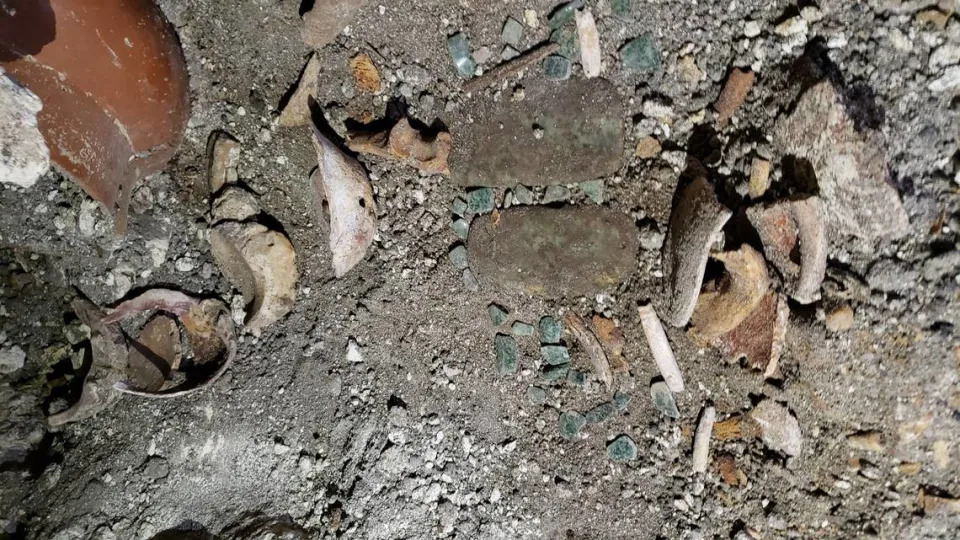
Underground tunnels dug by looters barely stopped just feet from the burial, according to archaeologists.
The team of experts, led by Francisco Estrada-Belli, found the burial in 2022, the university said in a Jan. 29 news release. They used lidar technology — “which shoots laser beams from an airplane through dense jungle foliage to map what’s on the ground.”
“It’s like taking X-rays of the jungle floor,” Estrada-Belli said in the release.
The lidar scans revealed the looters’ underground tunnels. About 6 feet from where they had stopped digging, the archaeologists spotted something in the ground.
It was the tomb.
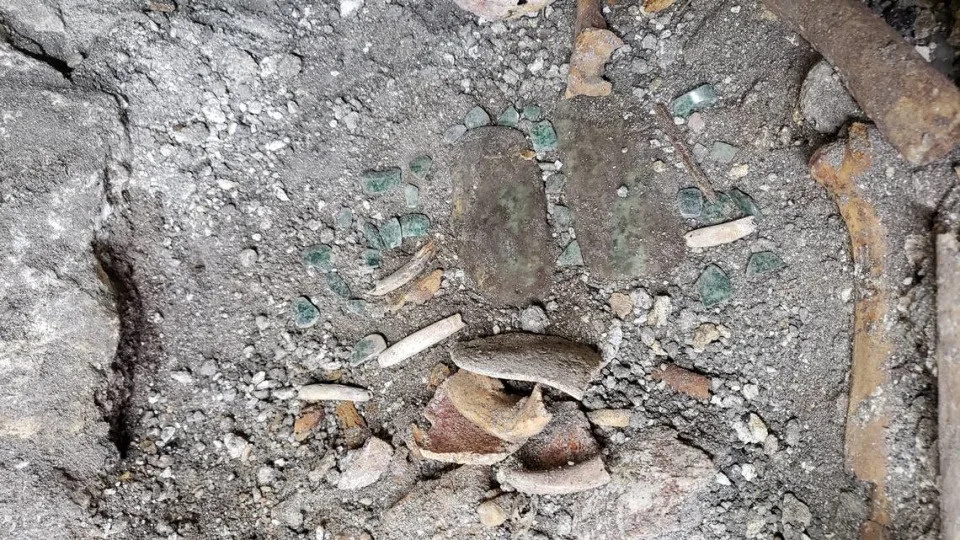
The only damage to the tomb was to its stone ceiling, the team said.
Because the looters stopped short of the actual burial, they only caused damage to the exterior of the stone tomb, according to Estrada-Belli.
“That was the first amazing thing about it,” he said. “It was very lucky.”
When researchers looked inside the tomb, they were even more shocked to find an assortment of “extraordinary funeral offerings, including a mosaic jade mask, rare mollusk shells and writings carved in human femur bones,” the university said.

The jade mask found in the Maya burial.
“A discovery like this is a bit like winning the lottery in terms of information,” Estrada-Belli said. “It opens a window into an obscure time we have very little texts about.”
Sixteen shells of “a rare spiny oyster” known as spondylus were fond in the burial, according to archaeologists. The shells were used by ancient royalty “as jewelry and currency as well as in religious and sacrificial offerings.”
One of the engraved femur bones depicts a profile believed to be an unknown king, experts said. He’s holding a jade mask similar to the one unearthed from the tomb. Hieroglyphics on the bone appear to identify the man’s father and grandfather, creating a link to other Maya states.
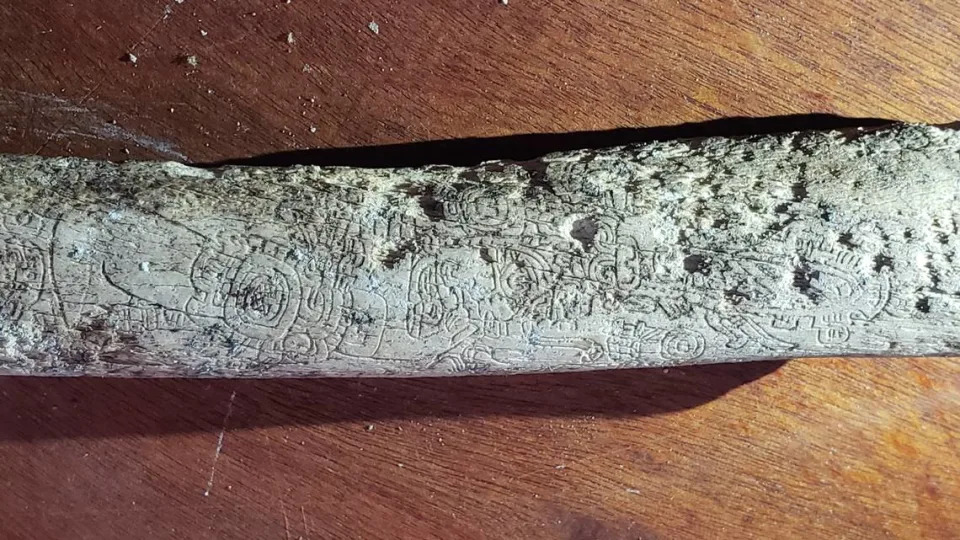
Engraved femur bones were also found within the tomb.

One of the engraved bones depicted the profile of a man holding a jade mask similar to the one found in the tomb, experts said.
The height of the Maya Classic Period was between 250 A.D. and 900 A.D., according to the university. Archaeologists know little about that time because most sites have been looted.
The relics date to about 350 A.D., experts said. They have connections to another Mayan settlement, Tikal, and the central Mexican site of Teotihuacan, “which influenced Maya rulers at the time.”
Archaeologists found the tomb at Chochkitam, a site in northeastern Guatemala, according to a 2022 study co-authored by Estrada-Belli. Chochkitam was “a center of average size,” but it had an important role as a royal city.
Aspen Pflughoeft
Fri, February 2, 2024
Near grazing rhinos and blowing grasses, a patch of rocks jutted out of the Kenyan landscape. The rocky area seemed easy to overlook. But, as an archaeologist recently discovered, it was actually home to some unique ancient creations.
Archaeologist Veronica Waweru visited Lewa Wildlife Conservancy last summer, according to a Feb. 1 news release from Yale University. Years before, she received a tip that tourists were looting the nature reserve’s prehistoric sites.
Waweru contacted the nature reserve and eventually visited herself, the university said.
During the visit, a staff member and amateur archaeologist took Waweru to see the reserve’s ancient burial mounds.
Near the burial site, Waweru noticed several “rows of shallow pits drilled into a rock ledge,” the university said. She identified the carvings as an ancient version of Mancala.
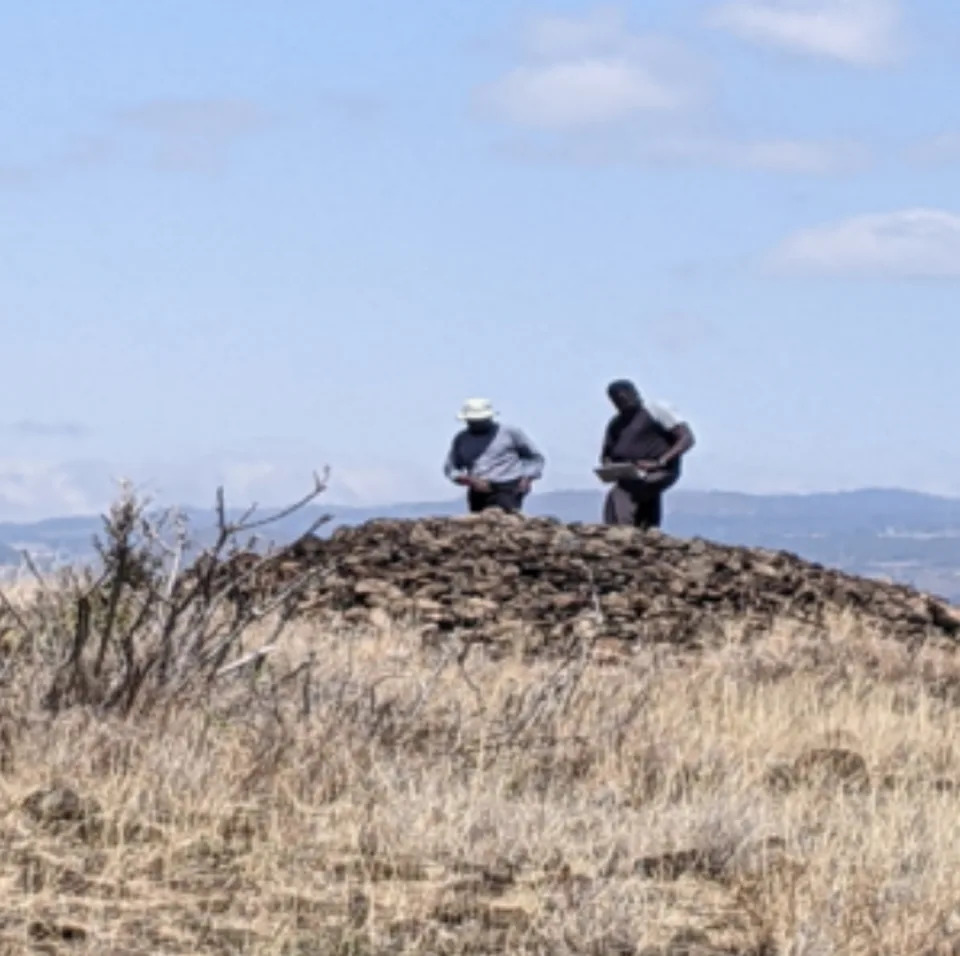
A burial mound in Lewa Wildlife Conservancy.
Mancala is “a two-player, strategy-based board game still played across the world today,” the university said. The game originated thousands of years ago, with ancient examples found in Egypt and other parts of Africa.
The site in Lewa Wildlife Conservancy had “about 20 ancient Mancala game boards” with varying levels of erosion, the university said.
“It’s a valley full of these game boards, like an ancient arcade,” Waweru said in the release. “Given the erosion of some of the boards, I believe people were playing these games there a very long time ago.”
A photo shows one of these ancient Mancala-like game boards. Dozens of holes are carved in two parallel rows. Each hole is deep enough to hold several stones used as game pieces.

The “ancient arcade” found at Lewa Wildlife Conservancy.
“Modern people in the region tend to play games like Mancala when they are out herding,” Waweru said. “That’s probably what they were doing here.”
The exact age of carvings is unknown. Waweru suspects the game boards vary in age with some being re-used or re-carved several times.
Waweru said the area has “been occupied over and over again throughout time. Within the last 10 thousand years, people played Mancala there … People tend to look at early life as brutish, nasty, and short. But perhaps life was not all about survival.”
Waweru hopes to study the site further in the future.
Lewa Wildlife Conservancy is about 110 miles northeast of Nairobi.
Moira Ritter
Thu, February 1, 2024

Toward the end of the seventh century, a warrior — dressed in a full set of armor — was buried beneath his horse in what is now Hungary.
For the last 1,300 years, his burial has stayed hidden. That is until November, when archaeologists were exploring the outskirts of Ebes, a village in eastern Hungary, and discovered the remains of a horse.
Beneath the horse bones, they found the warrior’s ancient burial, according to a Feb. 1 news release from the Déri Museum.
The armor was equipped with a wooden quiver holding arrows, a bow and a sword, archaeologists said. Archaeologists didn’t say if human remains were excavated from the burial.
Photos shared by the museum in a Jan. 31 Facebook post show the discovery on display.
The findings mark only the second time a complete and intact set of lamellar armor has been discovered, officials said. Lamellar armor is a style of armor that was used by ancient warriors.
City officials from Debrecen — which is located less than 10 miles northeast of Ebes — shared footage of the armor and weapons on Facebook.
Archaeologists believe the armor belonged to an Avar warrior from the end of the seventh century.
The Avar were people from Mongolia who established an empire in the region between the Adriatic and Baltic seas spanning the sixth and eight centuries, according to Britannica. They warred with other large empires, nearly occupying Constantinople in 626. By 805, the Avar submitted to Charlemagne, the first emperor of what became the Holy Roman Empire.
Moira Ritter
Thu, February 1, 2024
Hundreds of years ago, someone filled an oak box with a cache of coins. The box ended up buried next to what is now a street leading to a town center in France, and that’s where it stayed until 2021 when archaeologists found it.
Archaeologists were conducting a preventive excavation ahead of a real estate project in Guérande, according to a Jan. 31 news release from the Institut national de recherches archéologiques préventives (INRAP). That’s when they found the stash of coins, along with three others, dating to medieval times.
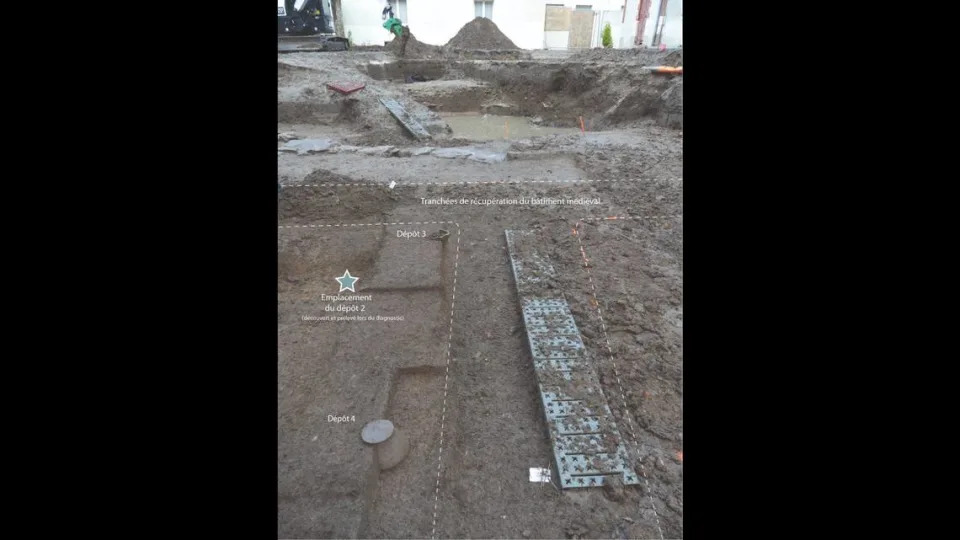
Three other deposits were found in the ruins of a 14th century masonry building, according to officials. © Edith Peytremann, Inrap
Ancient records mention Guérande as early as the ninth century, and experts said the town erected a wall sometime between the 13th and 15th centuries.
Research revealed that between the 12th and 13th centuries there was a medieval occupation at the site, officials said.
The box of coins was an isolated deposit that dates to between 1180 and 1204, according to archaeologists.
The three other deposits were found in the ruins of a 14th century masonry building, experts said. They date to between 1341 and 1342 and vary in preservation.
The best preserved collection of coins was found in a pitcher with a broken neck that was reused as a container. The pitcher was sealed with a pot turned upside down.

Linen envelopes holding coins were found within one of the deposits, experts said. © A. Cazin, Heritage Factory in Normandy
Researchers used 3D imaging to see inside the pitcher without damaging the artifact, officials said.
Inside the pitcher, archaeologists identified four linen fabric envelopes holding coins. The linen groups were placed inside a larger leather envelope.

The linen envelopes were held within a larger leather envelope, archaeologists said. © A. Cazin, Heritage Factory in Normandy
The other two deposits from the masonry building were less preserved, experts said. They were also sealed in ceramic containers and held traces of textile fragments among the coins.
Archaeologists said they have identified more than 2,000 coins from the deposits. They will continue examining the coins and the textiles from the deposits.
Guérande is about 330 miles southwest of Paris.
Google Translate was used to translate a news release from INRAP.
Bones found in 8-meter-deep pit may ‘fundamentally change’ history of humans in Europe
Katie Hunt, CNN
Thu, February 1, 2024
Microscopic fragments of protein and DNA recovered from bones discovered in 8-meter-deep cave dirt have revealed Neanderthals and humans likely lived alongside one another in northern Europe as far back as 45,000 years ago.
The genetic analysis of the fossils, which were found in a cave near the town of Ranis in eastern Germany, suggested that modern humans were the makers of distinctive, leaf-shaped stone tools that archaeologists once believed were crafted by Neanderthals, the heavily built hominins who lived in Europe until about 40,000 years ago.
Modern humans, or homo sapiens, weren’t previously known to have lived as far north as the region where the tools were made.
“The Ranis cave site provides evidence for the first dispersal of Homo sapiens across the higher latitudes of Europe. It turns out that stone artifacts that were thought to be produced by Neanderthals were, in fact, part of the early Homo sapiens toolkit,” said research author Jean-Jacques Hublin, a professor at the Collège de France in Paris and emeritus director at the Max Planck Institute for Evolutionary Anthropology in Leipzig, Germany, in a news release.
“This fundamentally changes our previous knowledge about the period: Homo sapiens reached northwestern Europe long before Neanderthal disappearance in southwestern Europe.”
The discovery means the two groups, who once interbred and left most humans alive today with traces of Neanderthal DNA, may have overlapped for several thousand years. It also shows that Homo sapiens, our species, crossed the Alps into the cold climes of northern and central Europe earlier than thought.
Three studies detailing the discoveries and lab analysis were published Wednesday in the journals Nature and Nature Ecology & Evolution.
Earliest Homo sapiens fossils found north of the Alps
The style of stone tool found at Ranis has also been discovered elsewhere across Europe, from Moravia and eastern Poland to the British Isles, according to the studies. Archaeologists call the tool style Lincombian-Ranisian-Jerzmanowician, or LRJ, in reference to the places where it was first identified.
To identify who made the artifacts, the team excavated Ilsenhöhle cave near Ranis from 2016 to 2022. When the cave was first excavated in the 1930s, only the tools were found and analyzed. This time around the team was able to dig deeper and more systematically, ultimately uncovering human fossils there for the first time.
“The challenge was to excavate the full 8-metre sequence from top to bottom, hoping that some deposits were left from the 1930s excavation,” said study coauthor Marcel Weiss, a researcher at Friedrich-Alexander University Erlangen-Nürnberg and the Max Planck Institute for Evolutionary Anthropology, in a statement. “We were fortunate to find a 1.7 metre thick rock the previous excavators did not get past. After removing that rock by hand, we finally uncovered the LRJ layers and even found human fossils.”
However, the human remains weren’t immediately identifiable among the hundreds of bone fragments unearthed during the six-year dig. It was only later the team knew definitively that the layers of sediment that contained the LRJ stone tools also included humans remains.
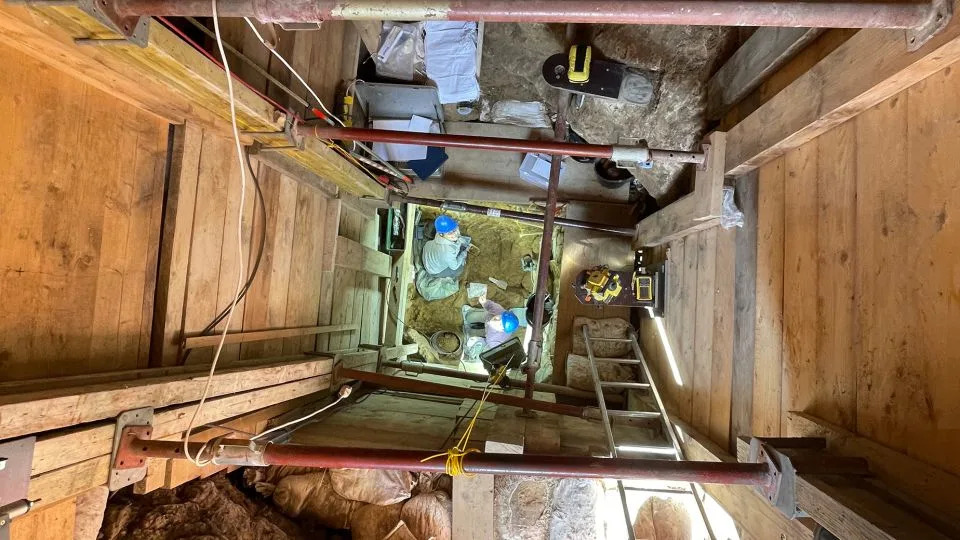
Excavating an 8-meter deep pit at Ranis cave was a logistical challenge and required elaborate scaffolding to support the trench, the researchers said. - Marcel Weiss
The researchers used proteins extracted from bone fragments to identify animal and human remains they found, a technique known as palaeoproteomics. It allows scientists to identify human and animal bones when their form is unclear or uncertain. Using the same technique, the team also managed to identify human remains among bones excavated during the 1930s.
However, the protein analysis was only able to identify the bones as belonging to hominins — a category that includes Homo sapiens and Homo neanderthalensis, or Neanderthals. To distinguish between the two, the team was able to extract fragments of ancient DNA from the 13 human fossils they identified.
“We confirmed that the skeletal fragments belonged to Homo sapiens,” said study coauthor Elena Zavala, a postdoctoral research fellow at the University of California, Berkeley, and Max Planck Institute for Evolutionary Anthropology, in the release.
“Interestingly, several fragments shared the same mitochondrial DNA sequences — even fragments from different excavations,” Zavala added. “This indicates that the fragments belonged to the same individual or were maternal relatives, linking these new finds with the ones from decades ago.”
Unexpected adaptability
Radiocarbon dating of the fossils and other artifacts in the cave suggested that these early humans were living there from around 45,000 years ago, making them the earliest Homo sapiens known to have inhabited northwestern Europe.
The region would have had a dramatically different climate then, with conditions typical of steppe tundra such as that found in present-day Siberia. The dig revealed the presence of reindeer, cave bears, woolly rhinoceroses and horses. The researchers also concluded that hibernating cave bears and denning hyenas primarily used the cave, which had only periodic human presence.
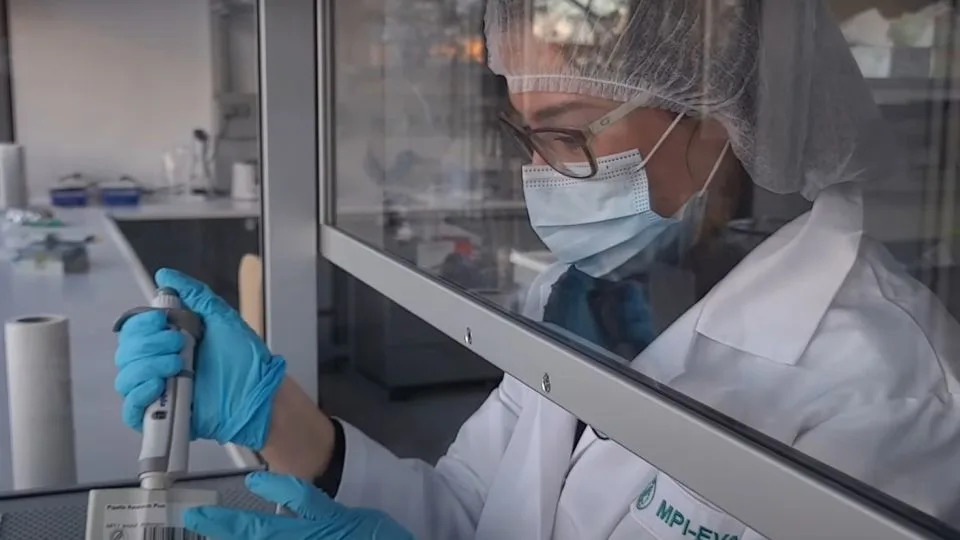
Extracting proteins from archaeological bone fragments must be performed in a sterilized environment to avoid contamination. - Dorothea Mylopotamitaki
“This shows that even these earlier groups of Homo sapiens dispersing across Eurasia already had some capacity to adapt to such harsh climatic conditions,” said coauthor Sarah Pederzani, a postdoctoral fellow at the University of La Laguna in Spain, who led the paleoclimate study of the site. “Until recently, it was thought that resilience to cold-climate conditions did not appear until several thousand years later, so this is a fascinating and surprising result,” she said, according to the news release.
William E. Banks, a researcher at the University of Bordeaux in France, said the studies showed how new methods are allowing archaeologists to examine sites in unprecedented detail, improving the ability to pinpoint when a site was occupied.
The “discoveries provide another important piece of the puzzle of this culturally and demographically complex period in Europe,” Banks noted in a commentary published alongside the studies. However, Banks, who wasn’t involved in the research, added that archaeologists “must be careful not to generalize findings from one or two sites.”
He noted that recent discoveries suggested Neanderthals were more culturally and cognitively complex than popular stereotypes suggest and that archaeologists should “not necessarily assume” in all cases that modern humans made more complex styles of stone tools from that pivotal period before Neanderthals disappeared.
Tim Newcomb
Wed, January 31, 2024
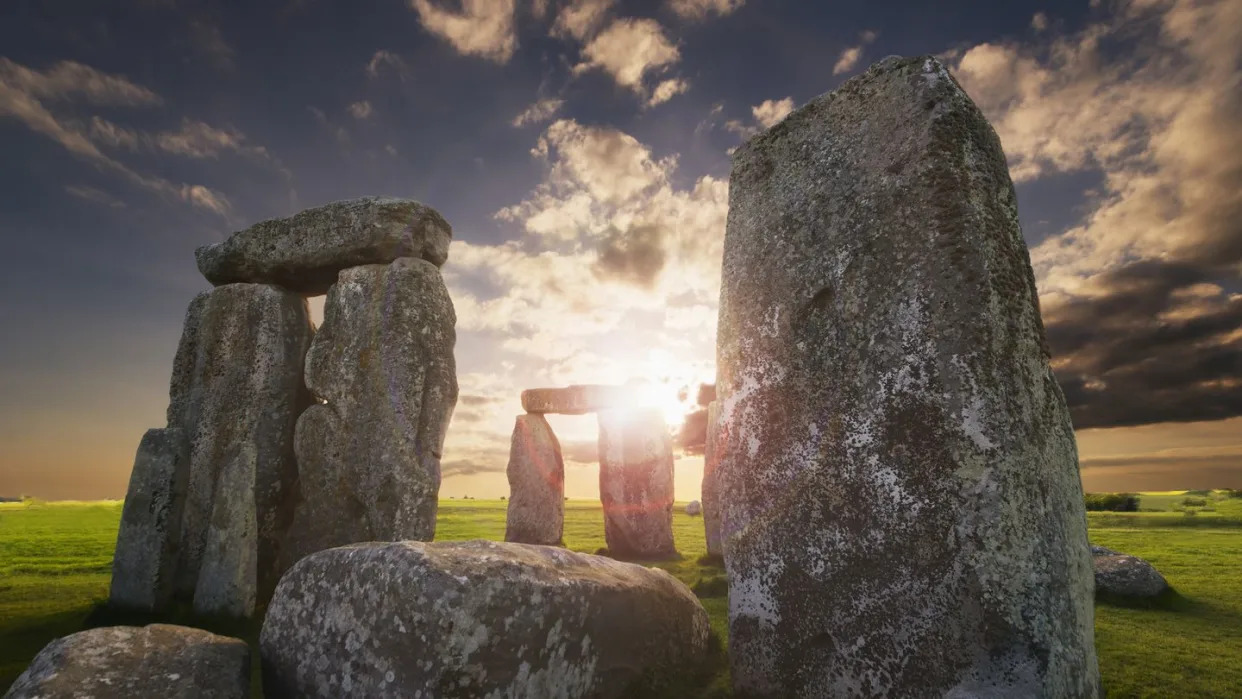
Tetra Images - Getty Images
Two mysterious sarsen blocks of Stonehenge may have come from much farther away than originally believed.
A new study places the origin of the stones up to 76 miles from the famous site.
The mixture of locales from which Stonehenge stones originated seemingly continues to grow.
Stonehenge hasn’t given up all its mysteries just yet, even though scientists are working to cut them away one by one. The latest scientific effort has been pointed towards identifying the origin of a pair of unidentified sarsen stones—numbers 26 and 160—that don’t neatly fall into past identification efforts.
The results may stretch our understanding of Stonehenge a bit—76 miles southeast, to be more precise.
In a new study published in the Journal of Archaeological Science: Reports, researchers employed X-ray fluorescence spectrometry and inductively coupled plasma mass spectrometry to analyze the chemical composition of 54 sarsen stone fragments culled from the 5,000-year-old site. This allowed the team to show that stones located at England’s Stonehenge have a more diverse provenance than previously believed.
Over the past few years, scientists have traced the origins of many of the remaining 52 stones at the site. These stones fall into a variety of differing categories, some grouped together and others standing solitary. The bluestones of the inner circle come from the Preseli Hills in Wales, and a variety of the sarsen stones (made of silcrete sandstone) were traced in 2020 to roughly 19 miles from Stonehenge. That site, known as West Woods and located in the southeast Marlborough Downs, was a key source of stone for Neolithic people—both because of the widely available supply and natural access points.
But not all the sarsen stones were linked to West Woods, and stones 26 and 160 remained mysterious. Plus, some original Stonehenge stones no longer reside at the site, making tracing quite tricky.
The team looked to find a match for the non-West Woods stones by investigating sarsen debris that had been excavated from Stonehenge trenches in 2008. While much of the debris did tie to the Marlborough Downs area—which includes West Woods, Monkton Down, and Totterdown Wood—the team also matched some debris to Bramdean, Hampshire (31 miles away) and Stoney Wish in East Sussex (76.4 miles to the southeast).
“This adds a second likely source area for the sarsen megaliths at Stonehenge in addition to West Woods,” the authors wrote. “At this stage, we can only speculate on the reasons why sarsen stone from such diverse sources is present at Stonehenge.”
The team added that one of the fragments sourced from Monkton Down was part of a “flake removed from the outer surface of a large sarsen boulder, most probably during on-site dressing. This adds a second likely source area for the sarsen megaliths at Stonehenge in addition to West Woods.”
The additional fragments, including the ones linking to East Sussex, could have come from the outer surface of stones 26 or 160, which are chemically distinct from other sarsen megaliths. The fragment may also be part of a now-missing stone.
“It is also possible that the analyzed fragments were pieces of saccharoid sarsen hammerstones of their pre-forms, or small blocks brought on-site for ceremonial or non-ceremonial purposes,” the authors wrote.
All the team can know for sure is that not all the fragments originated in the West Woods. While the findings answer some questions, they are far from the last word when it comes to understanding Stonehenge.
Treasure-filled jar — possibly an offering — found in sand near 1,800-year-old ruins
Moira Ritter
Wed, January 31, 2024
About 1,800 years ago, someone in the United Arab Emirates filled a pottery jar with a collection of treasures: several gold Roman coins, some local bronze currency and a bronze bracelet. Then, they took the jar to a nearby religious building as an offering.
Or at least that’s what archaeologists who just rediscovered the jar during excavations at the Tell Abraq archaeological site in Umm al-Quwain hypothesize.
The team of archaeologists recently finished their 2023-2024 excavations of the sprawling, multi-period site, according to a Jan. 28 post from the Umm al-Quwain Department of Tourism and Archaeology.
The latest explorations of the ancient settlement — which dates to as early as about 2500 B.C. and was inhabited until about 300 A.D. — found a variety of ruins and artifacts, officials said. Among the most exciting finds were the gold coins, which were a first-of-their-kind for the area.
Here’s what archaeologists found at Tell Abraq.
A treasure-filled pottery jar and a fully preserved building
Archaeologists said one of their most important finds of the excavation was a fully preserved building dating to between the first and second centuries A.D.
The building contained a single square room, and it was associated with several other finds, including the “most astonishing” discovery of the season, Michele Degli Esposti, the excavation’s co-director, said in the video.
Within the building’s ruins, a pottery jar containing Roman coins, local coins and a bronze bracelet were found, Esposti said. The jar may have been a ritualistic offering, and the building could have been a cultic center.
Experts said it’s possible the Roman coins, known as “Uri,” were minted in France and were spread east through the extensive Roman trade network, according to a Jan. 24 post from the department. The gold coins bear depictions of Tiberius, who was the Roman emperor from 14 A.D. until 37 A.D.
Archaeologists discovered Roman coins among other ancient artifacts in the United Arab Emirates, officials said.
The discovery marks a turning point in understanding the ancient site, indicating its important religious role and participation in trade networks.
Several stone statues, bronze figurines and clay figures were also associated with the buildings ruins, according to Esposti.
Additionally, an “outstanding” roughly worn stone with an fragmented inscription engraved on it was found in a rubble heap near the site, he said. Experts are working to translate the inscription, but it could be associated with religious practices.
A ‘remarkable’ metal figurine
Ruins of another ancient building, reduced to just a series of walls, were also discovered beneath years of built up sand, Ammar Albanna, who works for the department, said in the video.
Experts identified two construction phases of the building, according to Albanna. The first phase dates to the Iron Age, about 2,000 years ago. The second construction phase was later, indicated by different building techniques.
Within the ruins, archaeologists found a trove of artifacts.
Among their finds, experts found arrowheads, a knife, bronze coins and a “remarkable” metal figure which parallels finds from other Iron Age sites, Albanna said.
Three new graves from about 4,000 years ago
Archaeologists found three graves, dating to between the seventh century B.C. and the third century B.C.
One of the graves held two iron spears and two stone beads, according to Zoe Ceccato, an archaeologists on the project. Another held remains, including a finger with a ring on it.
Other graves had been found at the site during earlier excavations.
More ancient ruins
The remains of two other structures and a ditch equipped with an “outstanding” retaining wall were also found, archaeologists said in the video.
Within the first structure — a building described as a “unique monument” — experts found remains of a plaster floor and charred seeds, which dated to about the middle of the second millennium B.C.
The building has evidence of several architectural modifications, and archaeologists said the first changes were likely caused by a fire that caused damage shortly after the building’s initial construction.
The second structure dates to the Iron Age, around the first millenium B.C., experts said. Archaeologists uncovered plaster floor and several square-shaped structures that were likely used as bases for pillars or other removable features.
A deep ditch with a mud brick retaining wall was also found. Archaeologists said the bricks were covered with mud mortar and finger grooves left in the structure give insight into building techniques from the time.
The ditch was likely active between the end of the first and second millenia B.C., experts said.
Umm al-Quwain is in the northeastern United Arab Emirates.
Google Translate and Instagram were used to translate Instagram posts from the Umm al-Quwain Department of Tourism and Archaeology.

No comments:
Post a Comment